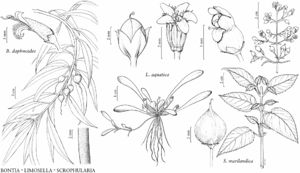Scrophularia marilandica
Sp. Pl. 2: 619. 1753.
Herbs, perennial, 10–30 dm; herbage light green to dark green, sparsely glandular-pubescent. Leaves: petiole length 1/3–1/2 blade; blade ovate to lanceolate, 10–19(–25) cm, length 2–3 times width, base rounded to cordate, margins regularly serrate. Pedicels slender, glabrate or stipitate-glandular. Flowers: corolla brown-red, unicolored, sometimes ± bicolored, paler abaxially, 5–8 mm, throat narrow; staminode clavate, length greater than width. 2n = ca. 86.
Phenology: Flowering Jul–Sep.
Habitat: Open woods.
Elevation: 0–1200 m.
Distribution
N.B., Nfld. and Labr. (Nfld.), N.S., Ont., P.E.I., Que., Ala., Ark., Conn., Del., D.C., Fla., Ga., Ill., Ind., Iowa, Kans., Ky., La., Maine, Md., Mass., Mich., Minn., Miss., Mo., Nebr., N.H., N.J., N.Y., N.C., Ohio, Okla., Pa., R.I., S.C., S.Dak., Tenn., Tex., Vt., Va., W.Va., Wis.
Discussion
Scrophularia marilandica has been confused with the European S. nodosa. Some North American floristic works have attempted to separate S. nodosa from S. marilandica using various characteristics including relatively shorter and narrowly wing-margined petioles, shorter leaves, stems acutely angled, corollas with green bases and tips of lobes, and nodular rhizomes. Nevertheless, the two cannot be reliably distinguished. Scrophularia nodosa has been reported from New Brunswick, Newfoundland, Nova Scotia, Prince Edward Island, and Quebec, and from Connecticut, Iowa, Massachusetts, Minnesota, New Jersey, New York, Pennsylvania, Rhode Island, and Washington (cultivated at the University of Washington Medicinal Herb Garden and present on and near the campus). Reports are generally based on collections from ballast in the 1870s and 1880s, other introductions of European plants associated with gardens and medicinal uses, and attempts to apply characters such as those above to North American plants. Plants in Newfoundland have generally been referred to as S. nodosa. While M. L. Fernald (1933) considered S. nodosa native in Newfoundland, later workers have treated S. nodosa as introduced in Newfoundland (for example, H. J. Scoggan 1978–1979).
Plants from maritime Canada that have been treated as Scrophularia nodosa, alternately as native to North America and as introduced from Europe, are treated here provisionally as of North American provenance and included in S. marilandica.
Although European plants of Scrophularia nodosa may have occasionally been introduced to North America, the extent to which they may have persisted locally is difficult to assess due to morphological variability and resemblance to North American plants. Linnaeus, while recognizing both S. marilandica and S. nodosa, stated that the distinction is scarcely merited. A review of literature also suggests that the two species may well be one.
Selected References
None.
